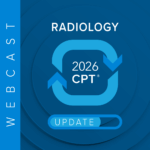Vascular embolization can prove challenging for many coders. Knowing the fundamentals of vascular embolization is important for successful CPT® coding. By gaining better comprehension of these services, healthcare coding and billing professionals can help ensure accurate coding while safeguarding full reimbursement. Let’s take a look at some of the details that define these codes when it comes to interventional radiology coding and billing. Here we explore 37241 and 37242.
Coding Breakdown and Fundamentals
How is code 37241 utilized?
Code 37241 is specific to venous embolization for clinical indications other than:
- Hemorrhage
- Tumors
- or organ ischemia or infarction.
| 37241 | Vascular embolization or occlusion, inclusive of all radiological supervision and interpretation,intraprocedural roadmapping, and imaging guidance necessary to complete the intervention; venous, other than hemorrhage (e.g., congenital or acquired venous malformations, venous and capillary hemangiomas, varices, varicoceles) |
Make sure that code 37241 is not assigned for extremity incompetent veins or spider veins.
Examples of appropriate clinical indications for 37241 include:
- embolization/sclerotherapy of gastric or esophageal varices
- varicoceles
- incompetent ovarian veins
- venous or lymphatic malformations.
Note that it would not be appropriate to report code 37241 for embolization of accessory (side) branches of an AV dialysis graft. Instead, see code 36909 for more information.
When is code 37242 reported?
Arterial embolization for reasons other than hemorrhage, tumor, organ ischemia or infarction is reported with code 37242.
| 37242 | Vascular embolization or occlusion, inclusive of all radiological supervision and interpretation,intraprocedural roadmapping, and imaging guidance necessary to complete the intervention; arterial, other than hemorrhage or tumor (e.g., congenital or acquired arterial malformations, arteriovenous malformations, arteriovenous fistulas, aneurysms, pseudoaneurysms) |
As noted in the code description there are several correct clinical indications for this code including:
- arterial malformations
- AV malformations, AV fistulas
- aneurysms
- and pseudoaneurysms
Understand that it is important not to assign this code for injection of thrombin into an extremity pseudoaneurysm as that is appropriately coded as 36002.
Circumstances When Chemoembolization or Radioembolization(Y90) is Planned
When hepatic chemoembolization or radioembolization (Y-90) is planned, other arteries such as the gastroduodenal or left gastric may be embolized to keep the chemotherapy or isotope from reaching other organs. If these arteries are embolized at the same session as the hepatic chemoembolization or radioembolization, only one embolization code (37243) would be assigned although additional vascular catheterization codes could be added. If these arteries are embolized at a session separate from the chemoembolization or radioembolization procedure, assign code 37242 (once) plus appropriate catheterization codes.
AAA Stent Graft with Endoleak Scenario
Patients with an abdominal aortic aneurysm (AAA) stent graft may be found to have an endoleak requiring embolization. An endoleak is not considered a hemorrhage but is rather a continued filling of the aneurysm either through accessory arteries or because the stent graft has become mispositioned. Embolization of the aneurysm or feeding vessel(s) resulting in the endoleak would be reported by 37242, not 37244. It may be necessary to approach the endoleak site by a translumbar injection, which would be coded 36160. However, understand that the NCCI Policy Manual for Medicare Services prohibits assigning a non-selective catheterization code such as 36160 with the embolization codes.
Circumstances Where the Balloon Catheters are Within the Internal Iliac
Interventional radiologists sometimes are asked to place balloon catheters within the internal iliac arteries prior to a C-section for a patient with placental issues and potential bleeding. If the balloons are placed but not inflated, report only catheter placements (i.e., 36245, 36246). If the IR physician is asked to inflate the balloons temporarily to prevent hemorrhage, report also 37242-52. Because both internal iliac arteries are in the same operative field, report 37242 only once.
As service volumes rebound, now more than ever it is imperative to make sure your CPT® coding is correct and compliant. Master more interventional radiology topics and break down the complexity with expert-infused insight. Our Upper Extremity Interventional Radiology Coding webcast is an essential training tool for both audio and visual learners.













